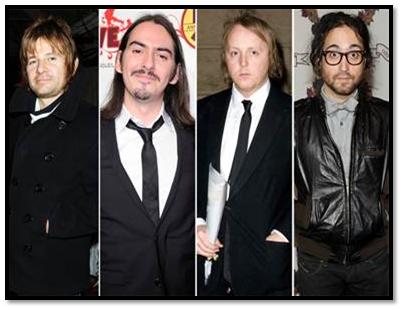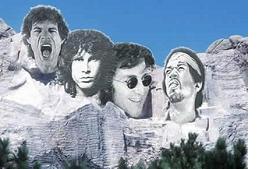Don’t blame me for the title of this morning’s post – it actually was written by msnbc.com’s Courtney Garcia. The story is about how James McCartney has apparently contacted Sean Lennon, Dhani Harrison, and Zak Starkey in an attempt to form the next generation of Beatles. (Thanks for the heads-up, Mr. Prep.)
(In the picture below from left to right, Starkey, Harrison, McCartney, Lennon.)
 Whether you think it is the coolest story of the year so far or the worst idea ever, it typifies the staying power of Classic Rock as an ongoing narrative. And it reminded me just how easy it is for the hundreds of Classic Rock stations all over America and the world to keep current even though they don’t play any.
Whether you think it is the coolest story of the year so far or the worst idea ever, it typifies the staying power of Classic Rock as an ongoing narrative. And it reminded me just how easy it is for the hundreds of Classic Rock stations all over America and the world to keep current even though they don’t play any.
Last week, Radio Ink’s Ed Ryan asked me to answer some key questions for a format review his publication is putting together. I was honored to represent Classic Rock, and responded to questions that ranged from “If you could give all Classic Rock PDs one piece of advice today, what would you tell them?” to “Where does Classic Rock fit in terms of popularity with consumers/listeners compared to other music formats?”
It’s the 27th anniversary of my first FM Classic Rock client, WMMQ/Lansing, Michigan (OK, it was actually Charlotte – pronounced Char-LOTTE). I seriously had no idea the music or the format would have this type of staying power when I drove away from the station trailer that April night after it signed on.
My misjudgment was thinking that the success of Classic Rock would be tied to that massive Baby Boomer audience that would always cherish the Beatles, Stones, Led Zeppelin, and the Who.
While that is part of the reason for Classic Rock’s success, the bigger story is that this music – and we’re talking now about scores of bands including Queen, Aerosmith, Fleetwood Mac, the Eagles, Journey, CSN(Y), and on and on – is some of the best ever made.
Just as the world has enjoyed symphonies and operas written and created centuries ago, many of these Classic Rock artists, albums, and anthems will be celebrated and loved for the rest of our lives – and beyond. The fact that many songs and the bands that performed them have achieved “second lives” through commercials, movie soundtracks, and TV shows speaks to the staying power of the music in our culture.
Yet, as the format has aged with the Baby Boomers who discovered these albums in dorms and rec rooms across America in the ‘60s and ‘70s, there are danger signs in the sales cubicles that many core listeners are aging out of the 25-54 advertising “sweet spot.”
 I continue to sit in meetings where we’re being asked to “fix” stations that aren’t broken. Classic Rock PDs are being challenged to add more ‘80s music, cut back on the ‘60s, and move the demos younger. The product is fine – it’s the sales and marketing that has traditionally not kept pace.
I continue to sit in meetings where we’re being asked to “fix” stations that aren’t broken. Classic Rock PDs are being challenged to add more ‘80s music, cut back on the ‘60s, and move the demos younger. The product is fine – it’s the sales and marketing that has traditionally not kept pace.
The fact is that passion for British Invasion era artists hasn’t gone away, and in some markets, continues to remain as strong as ever. And many Classic Rock stations are experiencing rating periods where they are seeing consistent support from 18-34s who have discovered the music.
Radio has spent too many years running away from successful formats that have lost some of their mojo due to changing advertiser demands. As Erica Farber ascends to head the RAB (a no-brainer move if I’ve ever heard of one), perhaps she’ll put “aging format demos” on her to-do list.
Radio would truly benefit from greater acceptance of the 35-64 demo, a cell that marketers, demographers, and statisticians will all tell you has more economic fire power than any other 30-year cell.
Now if we could only get those modern-day Mad Men to figure out how to market it, we’d be in business.
- Media And Technology In 2025: Believe It Or Not! - April 18, 2025
- In Radio, You Just Never Know - April 17, 2025
- The Secret To Making A Great Podcast (And Great Radio) - April 16, 2025




Hello Fred,
Your headline (Here come the Sons) was a real attention-grabber! GOOD ONE!
It would be terribly boring if I agreed with you. But(sorry) I agree with most of what you said, except for the fact that folks OTHER than BOOMERS would support the classic rock format. As a secondary format, YES. But as a P1? I’d be interested to see the percentage of how many P1’s are under the age of 45. Maybe THEN I’d change my mind.
It’s an all too-familiar story, though. For those of us that worked the “oldies” format in the 80’s & 90’s, the SAME thing is NOW happening with Classic Rock. I fear that the advertising “Mad Men”(and women) just…don’t…GET IT.
Remember when the oldies format ALSO played “the best music ever made,” from artists like Del Shannon, Little Richard, Elvis, the Beatles, Wilson Pickett, DC5, Motown, etc. These artists and their songs are also the favorites of TODAY’s aging Classic Rock superstars(notably Bruce Springsteen & Paul McCartney).
Unfortunately, as we Boomers age, more U2, Pearl Jam and STP songs make the “Classic” playlist…pushing more 70’s titles out the door. Until finally, the format either:
1)Morphs into something else
or
2)Dies a slow death, like “oldies” did
It’s happening, NOW, Fred. It’s been happening since the death of the oldies format. OLDIES was a BIG format, until the core hit 55+. Boomers are now over 50 in abundance. Until advertising people realize there’s GOLD in them-there 55+ listeners…older formats are doomed. So again, our job, is to try and convince ADVERTISERS AND THEIR AGENCIES that the format is worth buying into.
On another note, why on EARTH would they choose SEAN Lennon over JULIAN?? Another story for another day.
Best regards!
JC
JC, great points all. It’s not hard to visualize where this is heading. Thanks for drawing it up so clearly. (And yes, I had that Julian thought, too. I always liked him.) Thanks again.